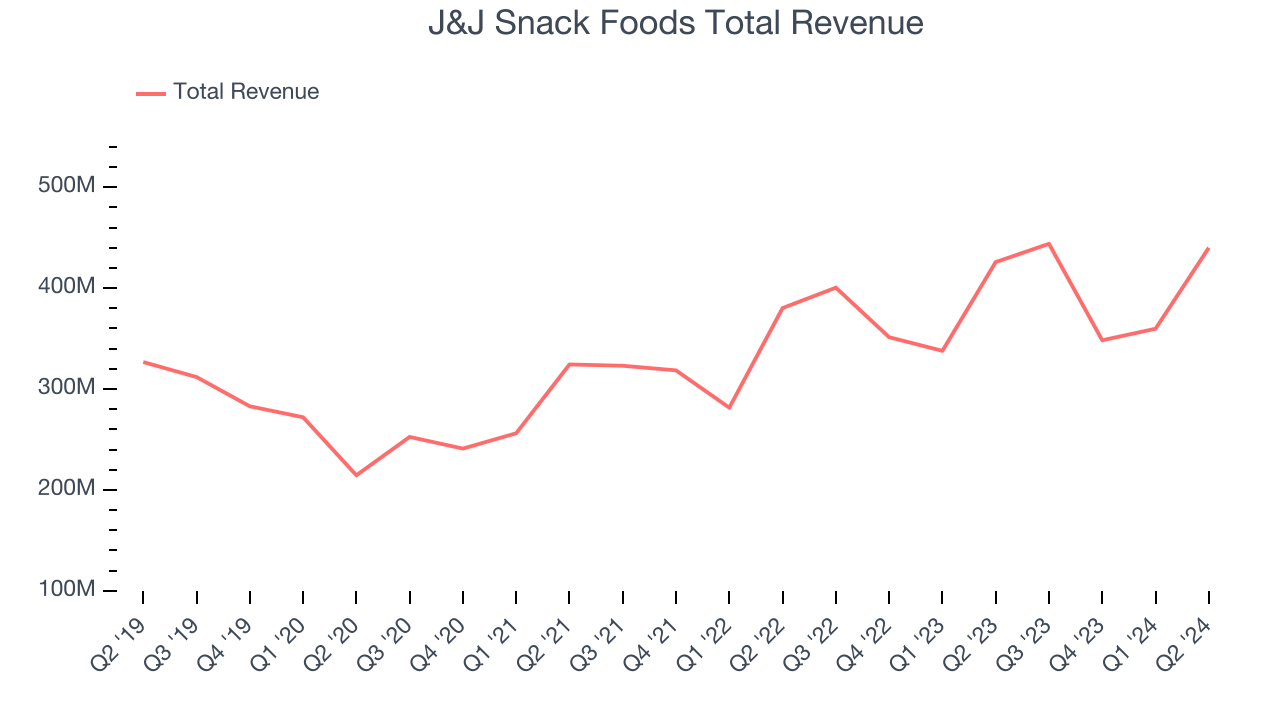Snack food company J&J Snack Foods (NASDAQ:JJSF) reported results in line with analysts' expectations in Q2 CY2024, with revenue up 3.3% year on year to $440 million. It made a non-GAAP profit of $1.98 per share, improving from its profit of $1.81 per share in the same quarter last year.
Is now the time to buy J&J Snack Foods? Find out by accessing our full research report, it's free.
J&J Snack Foods (JJSF) Q2 CY2024 Highlights:
- Revenue: $440 million vs analyst estimates of $440.9 million (small miss)
- Adjusted EBITDA: $70.9 million vs analyst estimates of $69.4 million (2.2% beat)
- EPS (non-GAAP): $1.98 vs analyst expectations of $1.99 (in line)
- Gross Margin (GAAP): 33.6%, in line with the same quarter last year
- Adjusted EBITDA Margin: 16.1%, in line with the same quarter last year
- Free Cash Flow of $94.66 million is up from -$3.95 million in the previous quarter
- Market Capitalization: $3.23 billion
Dan Fachner, J&J Snack Foods Chairman, President, and CEO, commented, “J&J Snack Foods delivered excellent third quarter financial results, including the second-highest quarterly net sales performance in our Company’s history and record quarterly earnings per diluted share. Top-line growth was driven by higher volumes across most of our core products and brands, as well as strong new business performance in our Food Service and Retail segments, partially offset by temporary challenges in the theater channel. Our continued success in improving operating efficiencies led to a healthy 33.6% gross margin, flat versus the prior year, despite a less favorable sales mix. This resulted in adjusted operating income growth of 3.9% and adjusted EBITDA growth of 6.3%, building on our solid momentum from the first two quarters of our fiscal year.
Best known for its SuperPretzel soft pretzels and ICEE frozen drinks, J&J Snack Foods (NASDAQ:JJSF) produces a range of snacks and beverages and distributes them primarily to supermarket and food service customers.
Shelf-Stable Food
As America industrialized and moved away from an agricultural economy, people faced more demands on their time. Packaged foods emerged as a solution offering convenience to the evolving American family, whether it be canned goods or snacks. Today, Americans seek brands that are high in quality, reliable, and reasonably priced. Furthermore, there's a growing emphasis on health-conscious and sustainable food options. Packaged food stocks are considered resilient investments. People always need to eat, so these companies can enjoy consistent demand as long as they stay on top of changing consumer preferences. The industry spans from multinational corporations to smaller specialized firms and is subject to food safety and labeling regulations.
Sales Growth
J&J Snack Foods is a small consumer staples company, which sometimes brings disadvantages compared to larger competitors benefitting from better brand awareness and economies of scale.
As you can see below, the company's annualized revenue growth rate of 14% over the last three years was solid for a consumer staples business.

This quarter, J&J Snack Foods's revenue grew 3.3% year on year to $440 million, falling short of Wall Street's estimates.
Unless you’ve been living under a rock, it should be obvious by now that generative AI is going to have a huge impact on how large corporations do business. While Nvidia and AMD are trading close to all-time highs, we prefer a lesser-known (but still profitable) semiconductor stock benefitting from the rise of AI. Click here to access our free report on our favorite semiconductor growth story.
Cash Is King
Although earnings are undoubtedly valuable for assessing company performance, we believe cash is king because you can't use accounting profits to pay the bills.
J&J Snack Foods has shown impressive cash profitability, giving it the option to reinvest or return capital to investors. The company's free cash flow margin averaged 7.1% over the last two years, better than the broader consumer staples sector. The divergence from its underwhelming operating margin stems from the add-back of non-cash charges like depreciation and stock-based compensation. GAAP operating profit expenses these line items, but free cash flow does not.
Taking a step back, we can see that J&J Snack Foods's margin expanded by 5.8 percentage points during that time. This is encouraging because its free cash flow profitability rose more than its operating profitability, suggesting it's becoming a less capital-intensive business.

J&J Snack Foods's free cash flow clocked in at $94.66 million in Q2, equivalent to a 21.5% margin. This quarter's result was good as its margin was 11.4 percentage points higher than in the same quarter last year, building on its favorable historical trend.
Key Takeaways from J&J Snack Foods's Q2 Results
While J&J Snack Foods missed slightly on revenue, adjusted EBITDA beat. Overall, it was a mixed quarter. The stock remained flat at $159.36 immediately after reporting.
So should you invest in J&J Snack Foods right now? When making that decision, it's important to consider its valuation, business qualities, as well as what has happened in the latest quarter. We cover that in our actionable full research report which you can read here, it's free.
